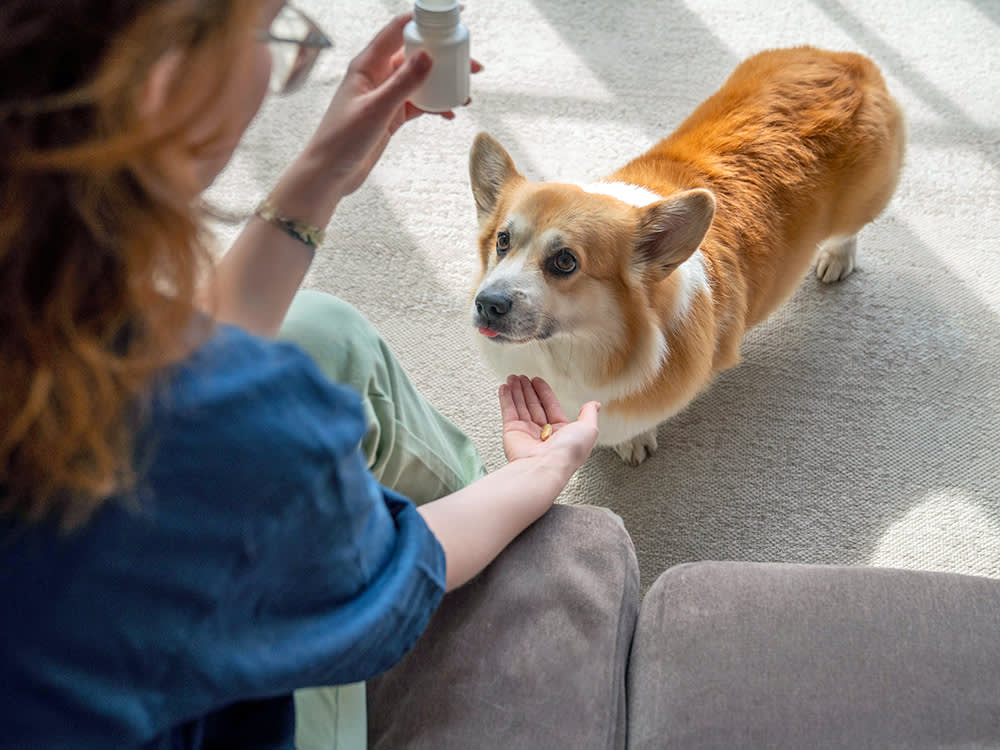Should You Give Your Dog Dramamine? Here’s What Vets Say
How to know if this is the right medication to give your dog or not.

Share Article
In This Article:
What Is Dramamine? Why Might Dogs Need Dramamine? What Is Dramamine Used For In Dogs? Common Dosage of Dramamine for Dogs Potential Side Effects of Dramamine Alternatives to Dramamine When to Consult With a Vet Bottom Line
You probably know what Dramamine is. Some people get very nauseous during travel, and many use Dramamine to curb that nausea during a car ride, airplane ride, or boating outing.
Dogs are no different. They can be significantly bothered by travel, and you may have wondered if human medications like Dramamine could help them.

Save on the litter with color-changing tech that helps you better care for your cat.
The short answer is “sometimes.” However, there’s more to it than that. Understanding when giving your dog Dramamine is appropriate, how much to give, and when alternatives might be better is crucial. Let's examine what veterinarians have to say.
What is Dramamine?
Dramamine, generically known as dimenhydrinate, is an over-the-counter medication used in humans for motion sickness. It is used to prevent nausea, vomiting, and dizziness, and it works by helping your body maintain its sense of balance. Dramamine belongs to a group of medications called antihistamines, and it helps calm the brain's response to movement and decreases inner ear disturbances.
The FDA has not approved Dramamine for veterinary medicine. However, veterinarians sometimes recommend it for their patients under the right circumstances and with the correct dosages. This is called using it “off-label” and is perfectly acceptable. From the FDA perspective, once the FDA approves a drug, veterinarians may prescribe it for an unapproved use when they judge that it is medically appropriate for their patient.
You may be asking yourself why your vet would want to prescribe a drug to treat a disease or medical condition for which the drug is not approved. One reason is that there might not be an approved drug to treat your dog’s disease or medical condition. Another is that you may have tried all approved treatments without seeing any benefits. In such situations, you and your vet may talk about using an unapproved drug to treat your pup’s disease or medical condition.
Why might dogs need Dramamine?
Dramamine can help dogs who:
Suffer from motion sickness during travel. Symptoms include vomiting, drooling, or panting heavily.
Become anxious during travel or unfamiliar situations. Some dogs associate car rides with stressful events, such as a trip to the veterinarian or the boarding kennel, which worsens their symptoms.
However, there are other methods or medications for treating these symptoms, and it’s important to know about them so you can choose the right one.
What is Dramamine used for in dogs?
Dramamine is primarily used for treating motion sickness and anxiety in dogs.
Motion sickness
Motion sickness is the most common reason a veterinarian may recommend Dramamine for dogs. Symptoms of canine motion sickness include:
Lethargy
Whining or barking
Vomiting
Excessive drooling
Fear or anxiety during travel
Dramamine can provide relief for these symptoms for most dogs. It affects the vestibular system in a dog’s inner ear, which is important in balance and motion detection.
Anxiety relief
In other cases, a vet may recommend Dramamine for its mild sedative effects. It’s not an anti-anxiety medication, but it can be beneficial for managing anxiety because its sedative effects can help mildly anxious dogs tolerate travel with less stress. For moderate to severe anxiety, though, vets have to prescribe more targeted anxiety medications.
Common dosage of Dramamine for dogs
Dosage is always important whether you’re giving animal or human medication. Giving your dog too much medication can be dangerous, while too little can be inadequate. Typical guidelines for Dramamine dosing in dogs include:
Give a dose of two to four mg per pound of body weight
Give that dose every eight hours as needed
If giving before travel, it’s best to administer 30 to 60 minutes before travel
Always consult your vet before giving the medication to confirm the correct dose and form (regular vs. non-drowsy versions, chewables, etc.). Not all types of Dramamine are safe; always use whatever your veterinarian recommends.
Potential side effects of Dramamine
Dogs do not always have side effects from Dramamine, but some do, and they may especially experience side effects if given the wrong dosage. Possible side effects include:
Vomiting or diarrhea
Sedation or drowsiness
Lack of coordination
Dry mouth
Urinary retention
In addition, it is possible to experience an allergic reaction to Dramamine. Symptoms could include facial swelling, hives, or difficulty breathing. If your dog experiences these symptoms, veterinary attention is needed.
Puppies, pregnant dogs, elderly dogs, or dogs with medical conditions may not be good candidates for Dramamine. Speak with your vet.
Alternatives to Dramamine
If you don’t want to give your dog Dramamine or find out your pup experiences too many side effects from the medication, there are alternative treatments. Some options include:
Prescription drugs for nausea approved by the FDA: One such medication is Cerenia (maropitant citrate), which is highly effective against motion sickness.
Homeopathic remedies: You can try ginger supplements, which are available in dog formulations and should provide mild anti-nausea effects.
Behavior modification: Try taking your dog for short car rides, gradually increasing the length. Over time, this can help with motion sickness.
Anti-anxiety medications: Drugs like trazodone, gabapentin, or specific dog-safe calming supplements can help with travel anxiety.
Thundershirts or calming wraps: These may help your dog feel less anxious by applying gentle pressure.
Be sure to match your dog’s needs with the solution. In other words, if you’re trying to treat motion sickness, be sure the medication is for motion sickness, not anxiety. The two different types of problems require two different remedies.
When to consult with a vet
Before giving your pup Dramamine or any human medication, consult your vet. Seek veterinary advice, especially if your dog has medical issues such as heart problems, urinary issues, kidney disease, or diabetes. Also, get advice if:
Your dog is pregnant or nursing.
You’re unsure which type of Dramamine is safe.
Symptoms persist despite treatment.
Your dog experiences severe side effects.
Depending on your pet's needs, your vet may recommend a safer or more effective alternative.
Bottom line
Some dogs experience motion sickness or anxiety when they travel. There are various prescription medications that your veterinarian can dispense to help your pup feel better in the car, on a plane, or even during a boat ride. However, many pet parents want to try an over-the-counter drug to make their dog feel better during travel. It is still recommended that you check with your vet before giving any medication to your dog.
One of the most common over-the-counter medications people use to try to help their dog with anxiety and motion sickness is Dramamine. Dramamine belongs to a class of drugs called antihistamines and is safe and effective for dogs. Even though it only has FDA approval for humans, veterinarians may recommend it for animals. That is called using the drug “off-label.
Dramamine must be used carefully and under veterinary supervision. While many dogs tolerate it well at the correct dosage, side effects are possible, and there are alternative treatments that may be safer or more effective for some pets.
Always consult your veterinarian before starting Dramamine or any medication, and monitor your dog closely when trying a new treatment. With proper planning and care, you can help your travel buddy enjoy the ride as much as you do.
References:
CONDER, G. A., et al. “Efficacy and Safety of Maropitant, a Selective Neurokinin1receptor Antagonist, in Two Randomized Clinical Trials for Prevention of Vomiting due to Motion Sickness in Dogs.” Journal of Veterinary Pharmacology and Therapeutics, vol. 31, no. 6, Dec. 2008, pp. 528–532, https://onlinelibrary.wiley.com/doi/10.1111/j.1365-2885.2008.00990.xopens in new tab
Noble, R. L. “ADAPTATION to EXPERIMENTAL MOTION SICKNESS in DOGS.” American Journal of Physiology-Legacy Content, vol. 154, no. 3, 1 Sept. 1948, pp. 443–450, https://journals.physiology.org/doi/abs/10.1152/ajplegacy.1948.154.3.443opens in new tab
Wang, S. C., and Herman I. Chinn. “Experimental Motion Sickness in Dogs Functional Importance of Chemoceptive Emetic Trigger Zone.” American Journal of Physiology-Legacy Content, vol. 178, no. 1, 1 July 1954, pp. 111–116, https://journals.physiology.org/doi/abs/10.1152/ajplegacy.1954.178.1.111opens in new tab

Dr. Shelby Neely, DVM
Dr. Shelby Neely is a freelance writer and veterinarian who graduated from the University of Pennsylvania School of Veterinary Medicine and has practiced veterinary medicine for thirty years, specializing in small animals. Her work has appeared in Allivet, AsktheCatDoctor, WhiskerDocs, Ask the Cat Doctor Radio, Ask the Cat Doctor TV, and numerous other websites, brochures, newsletters, newspapers, and ebooks. In her spare time, Dr. Neely likes to spend time with her three children, two grandchildren, three cats, two grand-cats, and five grand-dogs.
Related articles
CBD Oil for Dogs: Is the Green Stuff Good for Your Pup
There are options everywhere. Here’s how to sift through them — and how it could help your dog.
Can Dogs Get Headaches Too?
And what you should do if you think your pup is suffering.
![Young woman sitting in a chair holding and petting a small black Dachshund in her lap.]()
How a Little of the Good Stuff (CBD) Can Help Your Dog With Seizures
Here’s the info you need before you buy.
![woman comforts her dog]()
What Medication Can You Give Your Dog for Anxiety?
Here are some options your vet can help you consider.
![Red-haired woman holding sleeping dog in her lap on the bed]()
6 Reasons Your Dog Is Vomiting
And how to help them feel better fast.
![A woman looking out the window of a van with her dog.]()
How to Road Trip With Your Dog
A dog trainer shares her pro (and personal) #vanlife tips.







